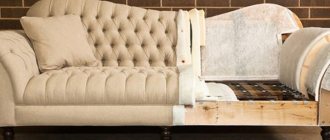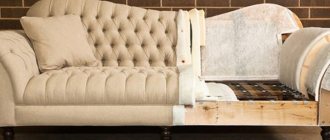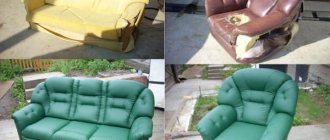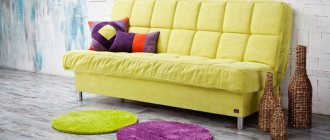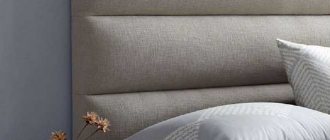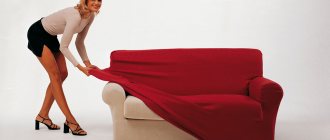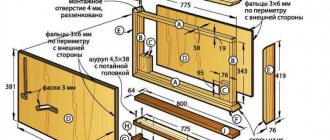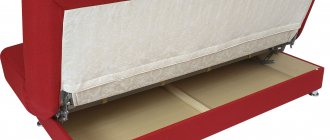Reupholstering a sofa is a forced measure, the need for which is determined by the appearance and various malfunctions of the furniture. Repairs are not difficult if you have some skills in working with tools and fabric.
You can make your work easier if you divide the entire process into stages, each of which has its own characteristics. But first you need to carefully study the theory, and also write down all the important points on paper, because in practice it does not always work out exactly as you would like.
Dismantling and important points
Before we begin purchasing material, we need to assess the scale of the work ahead.
To do this, perform the following sequence of actions:
- We evaluate the appearance - reupholstering does not always mean replacing the upper part. There is no point in changing the fabric surface if the frame inside is broken or the filler has sagged.
- Carefully rip open the sofa seat to understand the condition of its interior. To do this, you need to bend the staples with a sharp object and simply remove the linen covering. A flathead screwdriver does the job well.
- We assess the condition of the filler : whether it has sagged, dried out or deformed in certain places. After this, we determine whether it needs to be replaced.
- We carefully inspect the frame - for the sofa to remain strong, you need to make sure that there are no cracks in the wooden frame. The inspection is carried out after the internal parts of the sofa have been removed.
Expert opinion
Kokovin Dmitry Vasilievich
Furniture restorer
If the sofa has a block-spring seat type, then they should also be carefully inspected for defects. Usually such elements are not damaged and return back to their usual place.
So, at this stage we need to follow three main rules:
- We remove the upholstery as carefully as possible, removing each bracket one by one using a screwdriver. We do not throw away this fabric, since it will be our template that will allow us to correctly make a pattern from the new fabric.
- We carefully remove the inner part from the sofa and also do not throw it away. It will also act as a guide during reassembly. If these are block springs, then they just need to be covered with a new layer of foam rubber.
- If the sofa is large enough, then it is better to photograph all the individual details , so as not to get confused later about where and which element should be located later.
After dismantling is completed, the sequence of actions is as follows:
- Determine the type of fabric needed for the upholstery, as well as the dimensions for each individual piece and the overall size that will be taken into account when purchasing.
- Make calculations regarding the required amount of filler, and also select its type.
- Buy all the necessary materials and prepare the tools.
- Make the constriction, following the step-by-step instructions.
By following these simple rules, you will protect yourself from unexpected expenses, and also make your work more comfortable and faster.
To make the process easier, let's do all the steps step by step.
Furniture repair
First you need to determine the severity of the problem; the specific set of work depends on this.
Types of repairs
How to reupholster a sofa with your own hands - it involves replacing the upholstery and restoring furniture mechanisms:
- Replacing matter is the easiest way.
- Depending on the design of the sofa and the degree of its damage, replacement of the filling will be required; in more serious cases, repair of the spring blocks will be necessary.
- The shape of the seat has changed, the springs break through the bottom. In this case, the spring block is removed and replaced with fiberboard and plywood.
- If the frame deforms, you will need to completely disassemble the sofa and replace the old bars.
Upholstering a sofa becomes the only way to restore the attractiveness of upholstered furniture.
Choosing the right fabric
In order for the sofa to serve faithfully for decades, take care of high-quality upholstery that will protect it from moisture, dust and debris.
The modern textile market offers a lot of fabric upholstery for sofas, but the best of them are the following:
Gozhka
The most practical and inexpensive upholstery option, the service life of which is more than 10 years. Easy to clean, including wet cleaning. Not subject to deformation and various damages. The color does not fade when exposed to ultraviolet light.
Flock
Thick, soft fabric that is perfect for pet owners. Does not absorb moisture or odors, does not sag or deform under weight. It cleans well and has hypoallergenic properties.
Courtesan
The surface of the fabric is impregnated with special solutions that prevent moisture and odors from penetrating inside. It is very easy to clean and retains its color even after long-term use.
Forest
The best material that does not deform during operation. Does not absorb moisture and odors. When stains appear, they can be easily removed with a sponge and soap solution.
Boucle
An excellent option that is suitable for voluminous sofas. The fabric fits well on curves and non-standard shapes. The edge does not crumble and does not require additional processing.
Microfiber
The fabric does not fade, does not crumble and does not fade. Easy to clean with a vacuum cleaner. It belongs to the luxury class, so it is quite expensive.
Chenille
It has a wide range of colors that will fit perfectly into any interior. The fabric is dense, soft and practical.
Scotchgard
Dense but lightweight fabric that is easy to clean and does not accumulate dust on the surface.
When choosing fabric, follow these tips:
- Density and wear resistance - the higher these indicators, the longer the upholstery will last.
- Price is an important indicator, especially if you need to change the upholstery on fairly large furniture. Decide for yourself whether it will be a more expensive but durable material, or whether quality can be sacrificed in favor of preserving the budget.
- What kind of load will be placed on the covering - if there are children and animals in the house, and the sofa will have to be cleaned literally every day, removing stains and other dirt, then it is better to choose impregnated fabrics, which will greatly facilitate the housewife’s work.
Expert opinion
Kokovin Dmitry Vasilievich
Furniture restorer
Do not use leather or leather substitutes for upholstery. This is quite expensive and impractical, and if you spoil the material, you will have to purchase it again, wasting money. Such sofas require special care, and reupholstering them will cost the cost of a new sofa.
Each material is good in its own way and you can choose exactly the option that will be both reliable and affordable.
Classic sofa pie with a spring block and possible problems
To understand how to repair a sofa at home, you need to know what layers of materials are needed and in what order. For example, in a sofa seat with a spring block the sequence will be like this (from bottom to top):
- Frame made of plywood or wooden blocks. A plywood frame is more reliable, but it takes longer and is more difficult to make. Therefore, pine bars are usually used. They are connected according to the tenon-groove principle, gluing the joint with wood glue. If desired, the connections can be strengthened with dowels or corners (aluminum).
What layers should there be in a sofa seat? - Base for spring block . There may be options: lamellas (straps of elastic material), fiberboard, plywood. The most budget option is fiberboard, the most expensive is lamellas. The lamellas are attached to special stops (lamella holders). When using plastic stops, there is a risk of them breaking. At the same time, low-quality lamellas can bend (in normal condition they are curved slightly upward) or break - to reduce cost they are often placed at large intervals. All this leads to the fact that the sofa seat is pressed through. Instead of wooden slats, there may also be snake springs. They also have sufficient elasticity, but cost less. The problems with them are the same.
- The spring block itself . The block can be with independent or dependent springs. The first one is cheaper, the second one supports the body well. Such mattresses are also called orthopedic.
- Felt or thick fabric (teak or other similar dense fabric will do). This layer is needed so that the springs do not push through the foam rubber located above.
This is what the slats look like from below
If the fabric is thin, it will tear, then the foam will begin to crumble. But this is not the saddest thing - the lamellas were bent in the opposite direction. In normal condition they should be curved upwards
Using a grosgrain ribbon allows you to redistribute the load - Polyurethane foam (PPU, foam rubber - all names of the same material). Special dense foam rubber is used. If you choose, in addition to density, look at such an indicator as the durability coefficient - the higher the number, the better (and more expensive). This indicator reflects how long the foam will take to restore its original shape after removing the load. Its thickness is taken according to the original, factory cake. You can make it thicker without restrictions only on upholstered furniture that does not fold out (banquette, sofa, armchair).
- Sintepon . This is necessary so that the fabric does not “erase” the polyurethane foam. It is usually glued to a layer of foam rubber so that it does not bunch up during use. The glue is taken in a can.
- Upholstery fabric . The best are tapestry, chenille. They don't fray and it's easy to sew with them. Flock and jacquard are good fabrics, but some of them “creep” at the seams. Therefore, when you sew, the seams need to be strengthened. By the way, it is better to sew upholstery for a sofa using special Tytan brand threads. Regular ones, even thick ones, will quickly tear.
These are all the layers and their features. You can add something (for example, a double layer of padding polyester), but removing it is highly undesirable.
We count the footage
To calculate the total footage of the fabric used, you should calculate the length and width of each individual part, and then add these parameters. Keep in mind that when working, an allowance may be required, which is formed by increasing the volume of foam rubber or replacing the blocks with newer ones. Therefore, before purchasing, take 1 m more fabric than is needed, because when creating patterns, you will need to take an additional 3-5 cm of stock on each side.
After the footage has been calculated, you can go to the store and look at the assortment. As for the color scheme, the priority was, is and will be graphite, all shades of gray, burgundy and blue. These are the colors that are considered the most practical and not easily soiled for sofas.
How to pack?
Before you move your sofa to a new location after disassembling it, you need to think about packaging. This will protect the upholstery from dirt and damage.
In addition, this point is important for wooden elements, the presentation of which is very important. The packaging procedure is not difficult, however, there are a number of recommendations.
The best materials for packaging are cardboard, polyethylene film, and bubble wrap. You can secure them with regular tape.
Please note that each item must be packaged separately. Edges and hard corners must be lined with cardboard, and soft surfaces must be wrapped with film.
Each layer is fixed with tape. Fastening elements are placed in a specially prepared container, which must be tightly closed.
This will help you assemble the sofa faster, since everything you need will be at hand. If you perform all the steps correctly, the sofa will not be afraid of dirt and moisture. He will calmly tolerate not too careful external influences.
Choosing a filler
If the inside of the sofa is perfectly preserved and does not require replacement, then this step should be skipped, going straight to creating a pattern and reupholstering.
If the sofa has exhausted its resources, then its filler should be replaced, which can be of the following types:
Periotec
Non-woven material that includes natural fibers (coconut, flax, corn) and artificial components that hold their shape well and also provide elasticity and strength. The material is hypoallergenic, and its characteristics are quite capable of competing with a spring block.
Sintepon
A more budget-friendly option in the form of non-woven fabric, which is sold in rolls. By increasing the layers of padding polyester, you can adjust the degree of rigidity of the sofa itself. It is usually used as a layer between upholstery and polyurethane foam, which makes the surface soft.
Polyurethane foam
A highly porous material that holds its shape well, while being soft and comfortable enough to fill the seat and back of the sofa. It is absolutely safe for health, has a long service life, does not accumulate dust and unpleasant odors.
Spring block
Made to order according to your measurements, or selected from those options that are available. Keeps its shape perfectly and does not sag. It needs a felt layer that will protect the foam from the effects of springs.
Struttofiber
It is called “non-woven independent springs”, which perfectly retain pressure, distributing it evenly over the entire surface. It is one of the most practical and durable fillers today.
To calculate the required amount of filler, you need to measure the dimensions of individual parts of the sofa, as well as determine the thickness of the filler itself. If you take thinner options, such as padding polyester or holofiber, then you need to initially determine how many layers there will be.
If you are in doubt about which filling will have the best qualities specifically for your sofa, then try forming a sandwich from struttofiber, polyurethane foam and felt. This combination will be the most advantageous, since the struttofiber holds its shape perfectly, the felt protects it from sagging at a specific point of constant pressure, and the top layer of polyurethane foam provides the necessary rigidity.
The design of a sofa on snake springs and options for its restoration
Snake springs in expensive models are used as an additional means to increase elasticity. In budget models, a foam block can be placed on this base. They are attached to a wooden or metal frame across the seat - each spring separately. The installation step depends on the planned load. If your sofa begins to sag, or the springs have lost their elasticity or are broken, the solution is to replace them.
The spring, due to its elasticity, supports the materials on top
This is what it looks like disassembled
An expensive imported sofa is also made on a snake
To increase elasticity and extend service life, when reupholstering a sofa, the number of “snakes” can be increased. Another option is transverse reinforcement with rigid corsage ribbons (which are used for straps on bags and backpacks).
For durability and greater elasticity, use grosgrain ribbon
The tape is nailed on one side to the frame. Professional furniture makers then tighten it using a special tool, but it can be replaced with a regular block wrapped around the middle with coarse-grain sandpaper. You wrap a couple of turns of tape around this beam, pull with both hands (make sure that the frame does not bend), secure the tape with staples or nails, release and cut off the excess. The same method is also suitable for increasing the service life of a mattress with slats.
We prepare materials and tools
To work we will need the following tools:
- Construction stapler with metal staples for fastening upholstery.
- Stationery knife and scissors for cutting filler.
- A sewing machine for stitching individual parts of fabric if the width of the material does not allow you to obtain a solid pattern.
Before performing the main work, you need to prepare the upholstery fabric. To do this, we unfold the purchased section on the floor, and on top we lay out those parts that were dismantled earlier. Using sewing chalk, we trace the patterns, making an indent of 3-4 cm from each edge.
We arrange the patterns so that they fit on a piece of fabric. First we outline the largest parts, and then the smaller ones. We cut out the decor separately from the leftovers. If the fabric has a pattern, then it is better to make the pattern on the front side, making sure that each detail has symmetrical patterns.
Expert opinion
Kokovin Dmitry Vasilievich
Furniture restorer
If you have never reupholstered furniture, then for the first time it is better to avoid fabrics with patterns. It is quite difficult to make it symmetrical, but the material consumption can be 2-3 times higher than when using a plain fabric.
When the patterns are ready, you need to start filling. It is cut according to all parameters, laid and compared with the base of the sofa.
Design of the soft part of the sofa
The soft parts of the sofa are made in 2 versions: without springs and with springs.
If springs are not used, then:
- High density foam is used.
- Foamed latex is used, although it is more expensive than foam rubber, but it is more elastic.
If springs are used, then:
- Conventional springs are used, which are connected into a single unit.
- Snake springs are used in combination with foam/latex filling.
When restoring a sofa, you need to examine the layers
As a rule, these are the most common design solutions. If a complex option is offered using springs, as well as a layer of latex or polyurethane foam, then these are the most expensive models. Reupholstering such products is a troublesome task and requires professionalism.
The structure of sofa seats can be multi-layered
In fact, there may be more layers, since padding polyester or thermal felt is also added. But this option is not so expensive, although more modern. Some models may contain burlap, matting, batting, horsehair, dried seaweed, etc. Sometimes very exotic materials are used and finding replacements is not so easy. Therefore, it is better to replace them with similar materials, selecting the desired thickness. In any case, first of all, the sofa should be disassembled in order to understand what is inside this structure in order to determine the nature of wear of its elements.
Features and sequence of constriction
If everything you need is prepared, then you can proceed directly to work:
- We remove all structural parts of the sofa : back, seat and side parts, if any. First, we process the frame, which will be visible to the naked eye. Those parts that are hidden under seats or pillows do not need to be covered.
- We tighten the side parts: to do this, place the fabric on the floor, place the side, lightly pull the edge to the back side with your left hand and fasten it with staples to the surface, adjusting the tension force.
- We are working on the seat : we lay the filler, compact it well, and lay out the fabric pattern on top. On the reverse side we attach the first 3-4 staples, after which, carefully stretching the fabric, we upholster it around the entire perimeter. We make sure that the filler does not deform and does not roll into one part of the seat.
- We upholster the back : the sequence of actions is similar, but you need to pay special attention to the tension force. You should place your palm on the surface and press on it. If everything is done correctly, then after the palm is removed, the fabric will return to its original position.
If there are pillows on the sofa, then we upholster them. If the sofa itself consists of blocks, then the upholstery will occupy exclusively the side parts and the base. Cushions for the seat and back will have to be cut according to the specified parameters, then filler must be inserted there. It would be good if such a case had a hidden zipper. The covers can be removed and washed in the washing machine at any time.
The work will take even the most inexperienced craftsman about an hour. If everything is done correctly, the result will exceed expectations.
Have you ever had to reupholster a sofa?
It was a matter of I want to try
Recommendations
In order to avoid damaging the structure during the move, you should take into account some recommendations from specialists. Expensive sofas are often equipped with branded fasteners
To disassemble it, special tools are required, otherwise there is a possibility of damaging the upholstery or frame.
You should not try to disassemble such mechanisms yourself; it is better to seek help from professional craftsmen.
Caution also applies to individual models. The accordion mechanism often has special clamps in its design.
Removing the laundry storage box can be difficult. In the “book” and “eurobook” models, it is recommended to tighten the nuts onto the bolts immediately after dismantling.
There are a lot of these elements, they are very easily lost. In a corner folding sofa, it is the corner block that deserves attention.
It is non-removable, so it should be left in its original condition.
During debriefing, many problems arise after severe physical force is applied. This is strictly prohibited.
This is especially common if a compact folding mini-sofa is disassembled. All items are carefully stored in a specially prepared place so as not to lose them when moving.
This will help you quickly assemble the sofa in the new room.
When disassembling furniture with an old base, several nuances should also be taken into account. Repairing chipboard is more difficult compared to a sofa with a wooden frame. A lot depends on the condition of the frame.
Expert opinion Ekaterina Anatolyevna Smirnova has been engaged in interior design for 7 years, a professional architect
It is also important to take into account the age of the structure, since over time the fastenings will fit closer and closer to each other. Disassembling corner models can be more difficult compared to straight ones
During transportation, care must be taken to ensure that no moisture gets on the elements.
It is best to use a polymer film that is impermeable to water; it will hide the parts from unwanted exposure.
Caution is also required when working with draw-out models. This is especially true for families with pets.
Therefore, before you return the built-in compartment for storing bed linen to its place, it is worth checking that your pet will not hide in it. If this is not done, the animal may be injured.
When disassembling, not only the structure itself deserves attention, but also its dimensions, transformation mechanisms and material of manufacture. Experts recommend using only tools that are suitable for working with a specific model.
It is important to follow the dismantling sequence. If all conditions are met, there will be no problems during the work, and the product will be very easy to assemble in a new place
Using the example of assembling an accordion sofa, you can easily disassemble this model for transportation. All the details are in the video below.
FAQ
What should you do if, when stretching the fabric, its edge crumbles and falls off?
You need to treat it with an adhesive base after the fabric is attached using a stapler.
What to do if the sofa itself is large, and the width of the fabric roll is not enough to create the desired pattern?
There are two options here: either look for similar fabric in another store, where you can choose the desired width, or create a pattern from two pieces of fabric. It's good if the fabric is plain. If you have a drawing, you will have to work hard.
If you make a seat filling in the form of a sandwich, do all the layers (I decided to choose 3 layers) need to be held together with something?
Yes, they should be glued together using a special odorless glue. To do this, you first need to cut out all the fillings according to the template, then glue them together sequentially and allow them to dry thoroughly before installation.
Transportation rules
An important point when transporting furniture is to prevent it from moving freely in the back of the car. To do this, you need to secure it with a rope or stops. To avoid accidental staining, lay it down with cardboard. Try to initially place the overall part in the body of the vehicle, and the sidewalls and blocks can be placed nearby as stops. It is better to put pillows and other small items on top. It is advisable to use freight transport for transportation, but in order to save money, you can transport it in your own passenger car. To do this you will need a roof rack and a large interior. The main part of the sofa can be secured on top; before doing this, it is advisable to pack it well; it is better to transport small parts in the cabin and rear trunk.
Preparation
At the preparatory stage of reupholstering an old chair, no special actions are required. You just need to choose the right fabric with additional impregnation against dirt and wear, and also prepare all the necessary tools
It is important to immediately understand what the end result will look like, and therefore buy the materials yourself rather than order them on the Internet. It should be remembered that an overly old chair cannot be restored at home, and it is better to leave this task to a specialist
Otherwise, the seat or legs may fall apart, and the furniture will have to be thrown away. Professional craftsmen also recommend photographing the chair from different sides in order to assemble it without any problems in the future.
A couple more useful tips
- Always buy fabric with a reserve in case something doesn’t work out. It will NOT always be possible to purchase the missing quantity!
- Since reupholstering a sofa at home is a task that requires certain skills, you need to follow safety precautions, especially when removing old staples!
- To make the upholstery process more convenient, you can use a regular table.
- Before disassembling the sofa, take a photo of it, preferably each element separately. Also take a photo of the position of the sofa folding mechanism.
- When sewing, do not forget to allow 1 cm allowance.
Good luck to all masters!
Installing the cover on the frame
The cover is placed on the sofa and turned upside down.
This is the standard position for fixing it. We pull the rest of the fabric, this is about 4-5 cm, towards ourselves, but so as not to overtighten, and use a stapler to hammer the staples into the folded fabric.
We punch each subsequent staple at intervals of 3-4 mm.
Uniform tension of the fabric over the entire area is achieved due to some nuances of its “shooting”:
- You need to fasten the fabric in four places of the frame frame, not reaching the corners by about 5-6 cm.
- The corner parts are fixed last.
The photo shows a simple method for making corners:
If for some reason it is not possible to accurately calculate the old cut, you can use the presented fabric consumption table:
If this is a furniture corner, then divide the amount of fabric for the sofa in half
Using this table, you will approximately understand what yardage of fabric you will need for your type of sofa.
